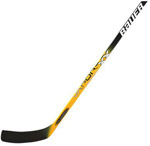Caring for your hockey equipment
Skates
 Dry of your skates
Dry of your skates
When you finish a game or practice you should rinxe the blades off under warm water and then dry them with a cloth. Otherwise, there is a danger that the blades will rust. A mistake that many players make is to put on skate guards right after drying their blades. Don´t! The skate guards probably contains slush that makes the blade wet again. Let the skate guards dry properly first before you put the guards on (before the game or practice).
Remember the inside
It´s not just the outside of your skate that have to dry out. Think about the inside. If you take out the insole you´ll see the rivets that hold the blade and boot together. If moisture penetrates beneath the insole there is a risk that the rivets will rust. If that happens the blades can come loose. After practice always take out the insole, loosen the laces widely, and fold the tongue forward so that your skates will dry thoroughly, inside! Your skates dry the best if you hang them upside down.
Dirty skate guards are no use
You also have to look after your skate guards. They often collect slush, sand and small stones in the grooves. If you don´t clean the guards you run the risk your blades getting nicked. If this happens moisture can penetrate and lead to greater demage. Ultimately this corrosion will lead to the blade breaking. You can easily check if your guards are clean by wipping the groove with a g-tip. Make a habit of regularly rinsing your guards with a hot water, at least once a week.
Game time
Check your skates regularly- carefully. Make sure the blade isn´t warped. Check your laces and replace them if they are frayed. It´s no fun to have a lace break five minutes before the starts.
Finally, loosen your laces properly and fold the tongue forward when you take your skates off. Lift your feet out of your skates; don´t pull the skates off. If you follow this simple advice you´re quaranteed that your skates will last longer and work better.
Sticks
 Sanpaper the shaft regularly
Sanpaper the shaft regularly
Make a habit of regularly sandpapering tshaft where you hold the stick. Use a fine-grain paper and you reduce the risk of slivers that damage your stick, your gloand your hand.
Extend stick lifetime
All stick blade are lacquered to protect against moisture. If the lacquer is worn water can penetrate the blade veneer and cause the wood to swell. This makes it brittle and can cause the blade to lose its shape and resilience. This is why it is important to let the stick dry properly after practice and games, preferably indoors. If the protective lacquer is damaged you can, after the stick dries, sand it with fine grain sand paper and then coat with a new layer of (transparent) lacquer. This will extend the playing life of your stick.
Helmet
 Never bend a dented cage back to its original position
Never bend a dented cage back to its original position
Regularly check that the chinstrap and every screw is tightened. If there is a screw that always loosens then try to fix it in place using something like colorless nail polish. Always use original screws. You also have tinspect the cage regularly. A seriously bencage can break the next time it´s hit by a puck. So if it is badly bent then you shoulreplace it. Never try to bend the cage basince that will make it even weaker. Visare the best cleaned with ordinary soap anwater or an anti- fog spray that also helpto prevent mist forming on it.
Gloves
 Let your gloves dry properly between practices and games. You can dust them with a little baby powder inside and outside to help drying and reduce odor.
Let your gloves dry properly between practices and games. You can dust them with a little baby powder inside and outside to help drying and reduce odor.
A hole in your glove doesn´t mean they are finished. Cut a piece of chamois (you can find it at your local gas station) and glue it on the inside with contact cement. You can also prevent the holes by gluing a piece of chamois where the glove is starting to wear.
Other equipment
You already know that neck guards, jockstraps, elbow pads etc can be machine-washed. Even shin pads can be washed. Soiled and sweaty pads can cause eczema and infections that can keep you out of the game for weeks. The easiest way to wash your pads is in washing machine at 30° C and use detrgent sparingly.
To avoid risking damage to the washing machine and protect the graphics on your pads you always put them in a washing bag.
Shopping basket
Basket empty.










